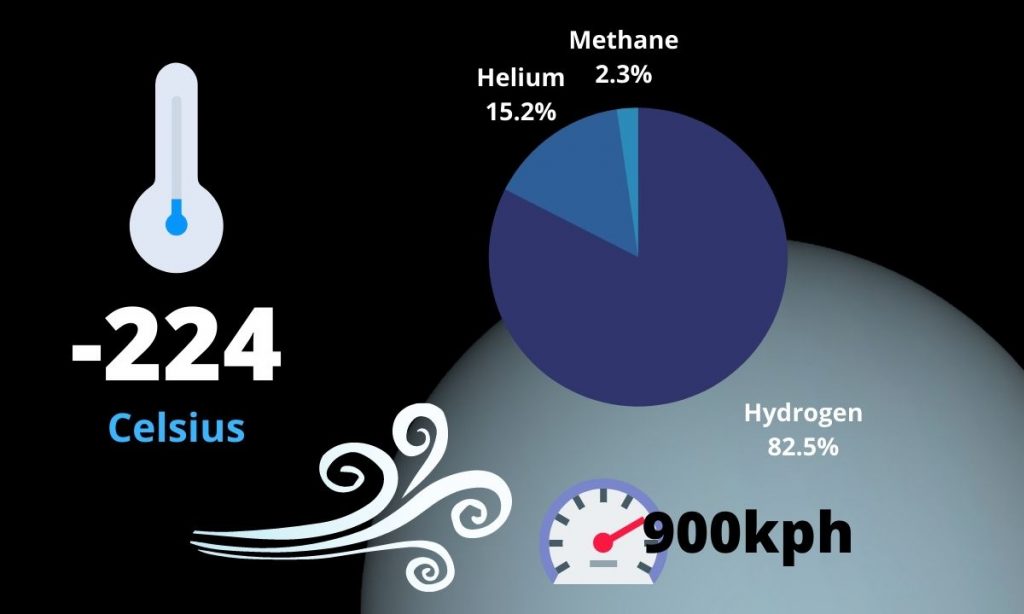Uranus is the seventh planet from the Sun and is the weirdest one, comparable to Venus. Therefore, let’s explore its distinctive features to learn more about the extremes of planets.
Basic Information
Before we know about the fantastic things about the planet, we have to mention its basic information. According to a NASA webpage, Uranus has a diameter of about 50,724 kilometers, about 4 times wider than Earth. Moreover, its mass is approximately 14.5 Earth masses, meaning that its gravitational acceleration is 0.9g.

Moreover, it orbits at approximately 19.1 astronomical units. As a result, it takes 84 Earth years to orbit the Sun. However, a rotation on Uranus only takes about 17 hours.
It Rotates Sideways
We didn’t mention something in the last section because it’s one of Uranus’s most outstanding features. It is its axial tilt, which is about 98 degrees.
What does that mean? Uranus is rotating on its side! In fact, its angle is slightly more than 90 degrees, so it rotates backward like Venus. That means a spot on that planet is in bright sunlight for 42 straight years, while the other side stays dark.
If you’re curious, you may ask, “How did this giant planet enter this state?” According to space.com, it is an object that weighs between 1 and 3 Earth masses.
The Atmosphere and Interior
Uranus’s atmosphere consists primarily of hydrogen and helium. Also, there is some methane, which absorbs red light and makes the planet look pale blue.
Moreover, its atmosphere is insanely cold, with a minimum temperature of -224 Celsius. That is nearly as cold as Neptune.
Furthermore, winds on Uranus is quite strong, like on other gaseous planets. Wind speeds can reach 900 kilometers per hour, which is more than twice the speed of the strongest hurricane on Earth.

Image Credit: Canva
However, it is not a gas giant. Instead, it’s an ice giant, in which its interior is not rocky or stuff like hydrogen and helium. Deep inside the planet, there are “icy” materials like water, ammonia, and methane.
Additionally, its core is quite frigid compared to other planets. While Earth’s core has a temperature of about 5,400 Celsius, Uranus’s core only measures about 5,000 Celsius, which is very cold when you consider other gas giants’ core temperature.
It Has A Peculiar Magnetic Field
Uranus also has a very notable feature: A bizarre magnetosphere. In fact, it is completely off course, at about 60 degrees away from the spinning axis.
That means if you bring a compass on Uranus, it will not be useful because the directions change all the time, even if the compass is static and not blown off by the wind.
Miranda — A Strange Satellite
Uranus’s inner moons are approximately “half water ice and half rock” (NASA Solar System Exploration, 2019). However, there is one satellite that appears to be very weird, and that’s Miranda.
The icy moon looks like a loosely-bound group of rocks, making the surface very uneven. That’s because tidal heating from Uranus heated up the interior of this satellite and reshaped the satellite.
Conclusion
In this article, we’ve briefly talked about Uranus and its features. We also discussed Miranda, which is an unusual, loosely-bound satellite. To further explore the planet, you can look at references 1-4 and 6-7 below.
References and Credits
- (n.d.). By the Numbers | Uranus – NASA Solar System Exploration. Retrieved January 22, 2021, from https://solarsystem.nasa.gov/planets/uranus/by-the-numbers/
- (2019, December 19). In Depth | Uranus – NASA Solar System Exploration. Retrieved January 22, 2021, from https://solarsystem.nasa.gov/planets/uranus/in-depth/
- Mike Wall. (2020, April 6). What smacked Uranus on its side? Something icy and as massive as Earth, scientists say. | Space. Retrieved January 22, 2021, from https://www.space.com/uranus-giant-impact-from-icy-massive-object.html
- Nola Taylor Redd. (2018, February 28). Uranus’ Atmosphere: Layers of Icy Clouds | Space. Retrieved January 22, 2021, from https://www.space.com/18708-uranus-atmosphere.html
- (2019, December 19). In Depth | Earth – NASA Solar System Exploration. Retrieved January 22, 2021, from https://solarsystem.nasa.gov/planets/earth/in-depth/
- (n.d.). In Depth | Miranda – NASA Solar System Exploration. Retrieved January 22, 2021, from https://solarsystem.nasa.gov/moons/uranus-moons/miranda/in-depth/
- Charles Q. Choi. (2014, October 3). Bizarre Shape of Uranus’ ‘Frankenstein’ Moon Explained | Space. Retrieved January 22, 2021, from https://www.space.com/27334-uranus-frankenstein-moon-miranda.html

